Headlines and events archive
Displaying 51 - 100 of 365
You may also find an archive of news published in the media which are related with the Instituto de Astrofísica de Andalucía - CSIC.
Pages

|
22/02/2023
CARMENES instrument multiplies the number of known planets in the solar neighborhood Twenty thousand observations of CARMENES, obtained from the 3.5-meter telescope of the Calar Alto Observatory (CAHA) are made public. The instrument, co-developed by the Institute of Astrophysics of Andalusia (IAA-CSIC), has made it possible to discover 59 planets, some of them in the habitable zone |

|
14/02/2023
The IAA-CSIC completes the first network of robotic telescopes present on the five continents Spain becomes the first country in the world to lead a global network of autonomous observatories. The BOOTES network, with seven facilities, is a pioneer in space surveillance and the study of transient cosmic phenomena, which shine briefly, intensely and suddenly. |

|
08/02/2023
The trans-Neptunian object Quaoar shows a ring that questions a theory used since 1850 The Institute of Astrophysics of Andalusia (IAA-CSIC) participates in the discovery of a dense ring in this object that, with a size equivalent to half of Pluto, raises several problems |

|
01/02/2023
Unexpected tails of gas and stars seen in two Hydra Cluster galaxies The IAA-CSIC leads the study of NGC 3312 and NGC3314a, two galaxies in advanced interaction with the cluster that should have lost most of their gas. The work, which seeks to understand how the environment affects galaxies within a cluster, reveals tidal tails with an anomalous amount of cold gas where stars are even forming |

|
25/01/2023
James Webb telescope observes the rings of Chariklo with a high-precision occultation technique The Institute of Astrophysics of Andalusia (IAA-CSIC) is leading an observation campaign with the JWST to capture the shadows of starlight produced by the thin rings of the object, located beyond Saturn. Subsequent observations revealed that crystalline water ice dominates the spectrum of Chariklo and its rings, suggesting that continuous micro-collisions are taking place there |

|
09/01/2023
The IAA-CSIC participates in two of the new surveys of the JAST80 telescope of the Javalambre Astronomical Observatory The last phases of stars and the formation and evolution of massive stars will be the objects of study of these new legacy projects |

|
15/12/2022
ESPRESSO and CARMENES discover two exo-Earths in the habitable zone of a star close to the Sun The Institute of Astrophysics of Andalusia (IAA-CSIC) participates in the discovery of a multiple planetary system around GJ1002 |

|
14/12/2022
The James Webb Telescope reveals that four to five stars were involved in the formation of the Southern Ring nebula The Institute of Astrophysics of Andalusia (IAA-CSIC) participates in a study that points to the interaction of a multiple star system in the formation of the nebula, which was featured on the cover of the journal Nature Astronomy |

|
13/12/2022
WEAVE first light The Institute of Astrophysics of Andalusia (IAA-CSIC) participates in the WEAVE scientific team, whose first observations already show the high quality of the data that the spectrograph will provide |

|
07/12/2022
A stellar collision that shone for almost a minute complicates the stellar explosion scenario The Institute of Astrophysics of Andalusia (IAA-CSIC) participates in the study of a gamma-ray burst (GRB) whose characteristics require a revision of the theoretical framework that explains these bursts |
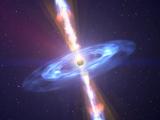
|
30/11/2022
Detected a jet of matter emerging from a supermassive black hole as it devours a star The Institute of Astrophysics of Andalusia (IAA-CSIC) participates in two articles that analyse this very rarely observed phenomenon |

|
23/11/2022
Determined how particle acceleration occurs in the jets of a supermassive black hole The Institute of Astrophysics of Andalusia (IAA-CSIC) participates in a study that suggests that shock waves could be at the origin of the acceleration of particles in the jets |

|
08/11/2022
The Institute of Astrophysics of Andalusia (IAA-CSIC) has been awarded the Severo Ochoa Centre of Excellence distinction for the second time The distinction, which provides centres with one million euros per year for four years, aims to finance and accredit institutions that demonstrate impact and leadership at an international level |

|
03/11/2022
The IAA-CSIC participates in ARRAKIHS, the European Space Agency's mission to study dark matter This is the first mission of the ESA Scientific Program coordinated by Spain. The IAA-CSIC will carry out the coordination of the observational strategy of the mission |
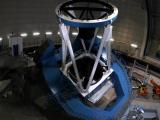
|
26/10/2022
The construction of TARSIS, the next generation instrument for the Calar Alto 3.5-metre telescope, has started TARSIS has unique features, in particular its ability to detect light in the near ultraviolet and its unprecedented field of view |

|
13/10/2022
IAA Severo Ochoa Meeting: Addressing Key Astrophysical Questions from Granada The Institute of Astrophysics of Andalusia (IAA-CSIC) organizes a meeting with specialists from all over the world on the most current problems in astrophysics |

|
10/10/2022
Study points to the existence of stars as compact as black holes The Institute of Astrophysics of Andalusia (IAA-CSIC) is leading a theoretical study that shows that some of the objects classified as black holes could actually be ultra-compact stars |

|
06/10/2022
The astronomy of the future will be collaborative, multi-wave, more diverse and green The Institute of Astrophysics of Andalusia (IAA-CSIC) hosted yesterday a round table with the heads of three of the largest astronomical infrastructures on Earth: the Cherenkov Telescope Array Observatory (CTAO), the Extremely Large Telescope (ELT) and the Square Kilometre Array Observatory (SKAO). The nature of these facilities, which will open new windows on the cosmos in gamma-ray, optical and near-infrared and radio astronomy, involves... |

|
20/09/2022
The largest European meeting on planetary sciences is held in Granada More than a thousand specialists participate in the congress, organized locally by members of the Institute of Astrophysics of Andalusia (IAA-CSIC) and held at the Palacio de Congresos. This great meeting has allowed the organization, at the IAA-CSIC, of a meeting with representatives of the European and American space agencies (ESA and NASA) on the JUICE (ESA) and Clipper (NASA) space missions |
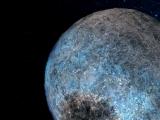
|
08/09/2022
Study reveals that water worlds may be more common than expected The Institute of Astrophysics of Andalusia (IAA-CSIC) leads a study that finds evidence for the existence of abundant extrasolar planets composed of ice and rock around dwarf stars |
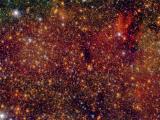
|
25/08/2022
First look at the prolific stellar factory at the center of the Milky Way A study, part of the GALACTICNUCLEUS project, coordinated by the Institute of Astrophysics of Andalusia (IAA-CSIC), reveals the history of star formation in the center of our galaxy |

|
07/07/2022
Possible galactic fossil found near Andromeda An unusual ultrafaint dwarf galaxy has been discovered, within the framework of a project led by the Institute of Astrophysics of Andalusia (IAA-CSIC), in the outer limits of the Andromeda galaxy. Named Pegasus V, it contains very few heavy elements and is likely to be a fossil of the earliest galaxies |

|
21/06/2022
The best studied terrestrial planet outside the Solar System An international scientific team, with the participation of the Instituto de Astrofísica de Andalucía (IAA-CSIC), has measured with unprecedented precision the mass and radius of Gliese 486 b, a "super-Earth" type exoplanet, discovered in 2021 with the CARMENES instrument at Calar Alto observatory. |

|
15/06/2022
Two hot, rocky exoplanets detected transiting a nearby star An international team led by the Instituto de Astrofísica de Andalucía (IAA-CSIC) has detected two telluric planets orbiting the nearby star HD 260655. |
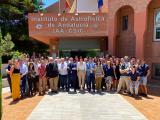
|
10/06/2022
Diana Morant visits the Institute of Astrophysics of Andalusia The Minister of Science and Innovation has highlighted the contribution of her research staff in capturing the first historic image of the black hole at the centre of the galaxy |

|
06/06/2022
Lourdes Verdes-Montenegro, researcher at IAA-CSIC, wins the Ada Byron Award from the University of Deusto The Ada Byron Award, with editions in six countries, was created by the Faculty of Engineering to acknowledge the work of women in technology and encourage women in STEM. |

|
25/05/2022
An isolated dwarf galaxy, unexpectedly affected by its environment The finding, with the participation of the IAA-CSIC, forces a change in the conception of isolated galaxies |

|
25/05/2022
The Ministry of Science and Innovation has earmarked 2.5 million euros for the international Square Kilometre Array radiotelescope The Square Kilometre Array (SKA) will enable progress to be made in the search for signs of life in the galaxy and in the observation of pulsars, black holes and gravitational waves. The technical coordination of the Spanish participation in the project is carried out by the Institute de Astrophysics of Andalusia (IAA-CSIC) |

|
25/05/2022
Westerlund 1 cluster: a nursery of giant stars emerging from the darkness The Institute of Astrophysics of Andalusia (IAA-CSIC) participates in the study of the most massive young cluster of stars in the Milky Way. This stellar swarm brings together different types of giant stars in different evolutionary phases, and constitutes a first-class laboratory for the study of the formation and evolution of massive stars |

|
24/05/2022
TARSIS, the next generation instrument for the Calar Alto 3.5-meter telescope UCM and IAA-CSIC co-lead TARSIS, the future instrument for the 3.5 m telescope at Calar Alto. TARSIS has unique characteristics, in particular its capacity to detect near ultraviolet light and its unprecedented field of view |
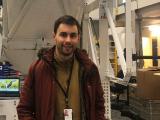
|
18/05/2022
IAA-CSIC engineer Francisco Bailén wins the 2021 award for the best thesis from the International Astronomical Union (IAU) Each year the award recognizes excellence in research in astrophysics |

|
12/05/2022
Astronomers reveal first image of the black hole at the heart of our galaxy This object, called Sagittarius A*, four million times more massive than the Sun, has been captured by the Event Horizon Telescope (EHT) international project. The finding, which has the outstanding participation of the Institute of Astrophysics of Andalusia (IAA-CSIC), confirms the existence of the black hole and helps to understand these gravitational 'monsters' from which nothing can escape, not even light. The image shows the dark... |

|
03/05/2022
The European Solar Telescope will boost research on the Sun in Europe The new infrastructure, which will be presented at an event at the CSIC, will have a mirror with a diameter of 4.2 meters and a height of 44 metres, and will be the largest solar telescope in Europe. Construction is scheduled to begin in 2024 at the Roque de los Muchachos Observatory, on the island of La Palma, and it could be operational in 2029 |
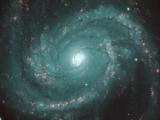
|
27/04/2022
An atlas of active galaxies shows that outflows are common even in the most dormant galaxies The Institute of Astrophysics of Andalusia (IAA-CSIC) studies in depth a sample of LINERs, the least luminous type of active galaxy, and finds that half of them produce gas outflows |

|
14/04/2022
MAGIC telescopes detect the explosion of a "vampire" star The Institute of Astrophysics of Andalusia (IAA-CSIC) participates in the discovery of very high-energy gamma rays from a recurrent nova in the Milky Way. The result, published today in Nature Astronomy, identifies novae as a new type of very high-energy gamma-ray source |

|
07/04/2022
Nkalakatha megamasser found, revealing a large galaxy collision The Institute of Astrophysics of Andalusia (IAA-CSIC) participates in the discovery of the radio emission produced by a galactic collision |

|
30/03/2022
The most distant star ever seen The Hubble space telescope sets a new record by capturing the light from a star that shone in the first billion years after the Big Bang. The Institute of Astrophysics of Andalusia (IAA-CSIC) is involved in the discovery, which provides a detailed view of the dawn of the universe |

|
23/03/2022
R Aquarii: a symbiotic star with active galaxy features The Institute of Astrophysics of Andalusia (IAA-CSIC) participates in the X-ray analysis of R Aquarii, a double star formed by a red giant star and a white dwarf. The system shows a very complex morphology, with a bipolar S-shaped jet emerging from the white dwarf and an extensive nebula with filaments and cavities |

|
14/03/2022
Bernardelli-Bernstein confirmed to be the largest Oort-cloud comet in the Solar System The Institute of Astrophysics of Andalusia (IAA-CSIC) participates in the study with the ALMA radiotelescope (Chile) of comet C/2014 UN271 Bernardinelli-Bernstein, which determined its size and albedo, or surface reflectivity. With 137 kilometres, it is the largest known comet, and perhaps one of the most pristine |

|
10/03/2022
The start of the birth of planets in a binary star system observed The Institute of Astrophysics of Andalusia (IAA-CSIC) leads the study of the binary star SVS 13, still in its embryonic phase. Astronomers have observed primordial material that may be giving birth to three planetary systems around a binary star |

|
04/03/2022
First results of the MASCOT project suggest that galaxies "turn off" from the inside out The Institute of Astrophysics of Andalusia (IAA-CSIC) participates in MASCOT, a large-scale study of the cold gas in galaxies, an essential element for understanding how galactic evolution works |
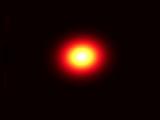
|
22/02/2022
Structure of the supermassive black hole at the center of our galaxy revealed The IAA-CSIC leads a study that reveals the almost circular shape of Sagittarius A*, the supermassive black hole located in the center of the Milky Way. The shape indicates that the axis of rotation of the flow of matter surrounding the black hole (or a possible jet) may be pointing toward Earth |

|
14/02/2022
Pulsars could hide one of the keys to understanding how cosmic rays travel The Institute of Astrophysics of Andalusia (IAA-CSIC) leads a study that analyzes the role of gamma-ray halos around pulsars in order to understand how cosmic rays travel |

|
01/02/2022
Second Trojan asteroid detected around Earth Trojans are asteroids that share an orbit with a planet around its stable Lagrangian points, which are located sixty degrees ahead and behind the planet in its orbit. Widely studied on other planets, such as Jupiter, which has several thousand, only one has so far been found around the Earth |

|
19/01/2022
Highest resolution image of the OJ 287 galaxy suggests it harbours a binary supermassive black hole The Institute of Astrophysics of Andalusia (IAA-CSIC) is leading a work that combines observations of space and ground-based radio telescopes to study the central regions of the galaxy OJ 287 |

|
17/01/2022
Plato exoplanet mission gets green light for next phase On January 11, ESA's PLATO mission, in which the Institute of Astrophysics of Andalusia (IAA-CSIC) participates, received the green light to continue its development after successfully passing the review of critical milestones |

|
13/01/2022
Re-encounter with a planetary nebula 30 years later reveals changes and a possible companion star The Institute of Astrophysics of Andalusia (IAA-CSIC) leads a study based on data from Calar Alto Observatory (CAHA), showing the variability of the planetary nebula IC4997 |

|
22/12/2021
Oxygen found in the atmosphere of the hottest known exoplanet A team with the participation of the Institute of Astrophysics of Andalusia (IAA-CSIC) publishes the discovery of oxygen atoms in KELT-9b, the first detection of this compound in an exoplanetary atmosphere. |

|
22/12/2021
Distinct pulses captured in the giant magnetic flare from a neutron star In just a tenth of a second, a magnetar -a particularly magnetic type of neutron star- released energy equivalent to that produced by the Sun in 100,000 years. Its study in detail has revealed multiple pulses at the peak of the eruption, which will make it possible to understand these still little-known giant magnetic flares |

|
16/12/2021
The dramatic final dance of stars with shared envelope The Institute of Astrophysics of Andalusia (IAA-CSIC) participates in the study of fifteen peculiar stars that have turned out to be double stars that, after sharing an envelope, lost a large part of their mass |